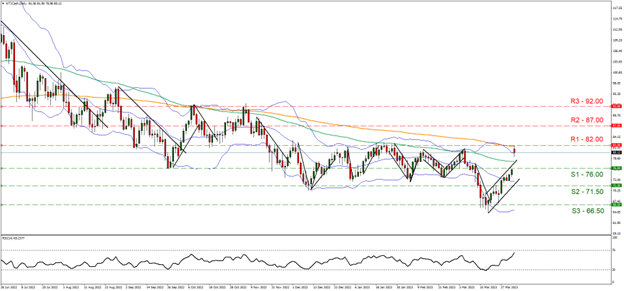Yesterday Sunday, OPEC+ shook the markets as it announced further oil output cuts to counter falling prices, attempting to restore price stability and safeguard their profit margins. WTI, the dollar-denominated benchmark for oil prices, soared 5% in today’s early Asian session and climbed to the $80 per barrel level where it is currently trading, as traders rushed to upwardly revise their outlooks, assimilating the new data. This report aims at analyzing the fundamental drivers influencing WTI’s price action and seeks to assess its future outlook and concludes with a technical analysis.

OPEC+ surprises the market with additional cuts
The oil cartel back in October decided to cut its output supply by 2 million barrels per day throughout 2023, and in its meeting minutes it was explicitly written that the group has “the ability to take further measures, if required, to achieve balance and stability in the market”. On multiple occasions the Qatari head of OPEC, Haitham Al Ghais alongside the Saudi energy minister Abdulaziz bin Salman al Saud, stated that the group would not hesitate to intervene and restore price stability in the markets, effectively signalling that the group remains vigilant and is ready to act should prices deviate substantially from the cartel’s target range. Fast forward to where we stand today, crude prices have been slowly shedding value, easing from the near $90 per barrel in mid-October to averaging just $75 per barrel during the past week. Reasons that aided the decline were the worldwide recession fears following the banking “confidence crisis”, depressed economic activity outlooks and below-trend growth projections for most developed nations. Seeing this apparent deviation of market fundamentals and the price of crude, OPEC+ announced yesterday Sunday, that additional production cuts of 1.16 million barrels per day will take place from May and would last for the entirety of 2023. Furthermore, Saudi Arabia pledged a “voluntary” 500k barrels per day reduction and market analysts now await for any response and/or retaliatory actions from the US. US-Saudi relations have slowly been loosening over the past year and the recent speculations that the Saudis seek to join the BRICS alliance may signal upcoming turmoil, threatening the reign of the petrodollar. Back in November, Saudi officials signalled that the kingdom is actively seeking to expand partnerships to serve economic and security interests, irrespective of the recent warnings drawn from the West, criticizing the dealings between nations of the Gulf with both China and Russia. Overall, the over 1-million-barrel production cut announcement by the coalition is expected to provide support for oil prices in the longer-term, nudging energy traders and analysts to upwardly revise their outlooks for the commodity.
US Department of Energy cites problems at restocking SPR inventories
Late last week, US Energy Secretary Granholm announced that the US Energy Department would stave off crude purchases aimed at replenishing the Strategic Petroleum Reserves of the country and cited that the restocking process would take years to complete. Biden administration officials stated in early January, that the US will replenish its crude stocks once WTI’s price edges closer to their $72 to $67 per barrel range and that a “calculated purchasing phase” would take place once the pricing conditions are “at or below the favourable range”. The US tapped its Strategic Petroleum Reserves back in 2021, as President Biden ordered a 50-million-barrel release amidst the rapid increase of petrol prices and another humongous 180-million-barrel release around September of 2022 following Russia’s full-fledged invasion in Ukraine, to keep a lid on petrol prices and protect the public at the pump. The enormous drawdowns left the strategic reserves severely depleted and currently stand at their lowest levels since 1983 according to EIA. Even though government officials stated in the past the administration is in no rush to replenish the reserve, energy traders nevertheless were expecting a large purchase and since that didn’t happen, they downgraded their optimistic bets, dragging momentarily WTI prices to lower ground. That all changed yesterday however, as OPEC+ announced further production cuts and boosted WTI’s price above $80 per barrel in today’s early Asian session, leaving the White House vulnerable for further backlash and criticism, as the opportunity appears to have slipped through their fingertips. Furthermore, the timing of the announcement by OPEC+ seems rather peculiar to say the least, as it came days after the Department of Energy’s comments and at a ministerial conference, rather than the official OPEC international meeting, with speculations pointing out a deliberately targeted response from the cartel.
テクニカル分析
WTI Cash H4

Looking at WTICash Daily chart we observe crude prices escaping from their 15-month lows and climbing higher as indicated by the ascending channel, incepted since the 20th of March. Earlier today, energy traders quickly reacted to OPEC+ surprise production cuts and long orders started piling in, boosting WTI prices to levels once seen before at the start of the year. Given the announcement is ought to impact supply levels, we hold a bullish outlook bias for the commodity. Supporting our case is the RSI indicator below our daily chart which currently registers a reading of 65 showcasing bullish sentiments in favour of crude. Furthermore, the break above the upper bound of the Bollinger Bands serves as another indication that the bulls are currently in control. Not only that, but the break of the price action above the 100-day MA adds more credit in our bullish case. Should the bulls capitalize on the positive sentiment, we may see the break above the 200 MA and the 82.00 (R1) resistance level and price action heading to higher ground, closer to the 87.00 (R2) resistance barrier. Should on the other hand the bears take over, we may see the commodity retracing its steps, breaking below the 76.00 (S1) support level and moving closer to the 71.50 (S2) support base.
Disclaimer: This material is for general informational & educational purposes only and should not be considered as investment advice or an investment recommendation. T4Trade is not responsible for any data provided by third parties referenced or hyperlinked, in this communication.


